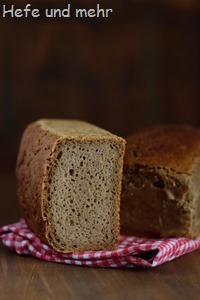 Last autumn we spent a week in East Frisia. Our land lady told us, that the bakery around the corner should be the best of Leer and so we had to buy some bread there, of course. Something that rouse my curiosity was a small package of sliced raisin bread called Krintstuut. As it was a busy morning in the bakery, I didn’t ask about the ingredients. Tasting the bread back in our cottage, I was sure that it contained a good portion of rye. And so I used a quieter time in the bakery to confirm my assumption.
Last autumn we spent a week in East Frisia. Our land lady told us, that the bakery around the corner should be the best of Leer and so we had to buy some bread there, of course. Something that rouse my curiosity was a small package of sliced raisin bread called Krintstuut. As it was a busy morning in the bakery, I didn’t ask about the ingredients. Tasting the bread back in our cottage, I was sure that it contained a good portion of rye. And so I used a quieter time in the bakery to confirm my assumption.
Finding rye in a sweet bread is nothing that surprises me any longer as I learned about so many traditional sweet breads baked that way. And it makes sense so much: Rye growth even in regions which are not suitable for wheat. So rye was always a grain used for many peasant breads. Wheat bread was something baked only for holidays. And even sweet breads with rye was something most families ate only on Sunday.
My interpretation of the recipe takes into account what I learned about bread baking in the 19. century: It uses sourdough but as well yeast. Back in time, the yeast was bought often at breweries and used for the “finer” breads like raisin bread.The sweetness stems from raisins alone as sugar was scarce back then. And that is really sweet enough. The bread is delicious, especially with some butter and honey.
Continue reading →
 A dear reader told me last year about a speciality in the north-western Part of germany: Campingwecken (lit. Camping rolls). She descripted it as a roll filled with a mixture of roasted almonds and pearl sugar. I was intrigued and started researching. It seemed, that the variant with almond is a rare one, more commenly is a variant with only pearl sugar. I even found a bakery who offered this kind of rolls in the city of Leer in our last vacation in East Frisia, so I could try this roll.
A dear reader told me last year about a speciality in the north-western Part of germany: Campingwecken (lit. Camping rolls). She descripted it as a roll filled with a mixture of roasted almonds and pearl sugar. I was intrigued and started researching. It seemed, that the variant with almond is a rare one, more commenly is a variant with only pearl sugar. I even found a bakery who offered this kind of rolls in the city of Leer in our last vacation in East Frisia, so I could try this roll.



 A sweet treat which seems to be perfect for Easter Sunday breakfast is the traditional Aachener Streuselbrötchen (Streusel rolls from Aachen). They stem – as the name suggested – from Aachen and are not known above the city borders. And that is a pity, as they are so delicious, especially if you are a devoted streusel lover like I am. So I try today to get these rolls the national (or even international) attention they should have.
A sweet treat which seems to be perfect for Easter Sunday breakfast is the traditional Aachener Streuselbrötchen (Streusel rolls from Aachen). They stem – as the name suggested – from Aachen and are not known above the city borders. And that is a pity, as they are so delicious, especially if you are a devoted streusel lover like I am. So I try today to get these rolls the national (or even international) attention they should have.



![Martinsbrezel (2)[5] Martinsbrezel (2)[5]](https://www.hefe-und-mehr.de/wp-content/uploads/2018/11/Martinsbrezel-25_thumb.jpg)